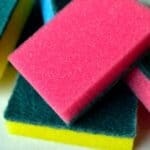Not all sponges are created equal—and if you’ve ever scratched a delicate glass or smeared grime instead of wiping it away, you already know that. The truth is, grabbing any sponge for every cleaning task doesn’t cut it.
With so many types of cleaning sponges for cleaning out there, it’s easy to overlook the perfect one for your needs.
From scrubbing dirty pots to polishing bathroom surfaces or even tackling pet hair on fabric window coverings, your sponge can either be your best cleaning tool—or your biggest mistake. Surprisingly, the average U.S. household goes through 2–3 sponges a week, often using the wrong type on the wrong surface.
In this guide, you’ll discover the different types of cleaning sponges, what they’re best for, and how to match the right sponge to the job. Because when it comes to cleaning, the right sponge can make all the difference.
Ready to find your perfect match?
Why Choosing the Right Sponge Matters?
That simple sponge in your hand? It’s not so simple after all.
Different sponge types are made with different materials, including abrasive material —each offering a unique level of abrasiveness, absorbency, and resistance to bacteria. And yes, that directly affects how well (or poorly) it tackles your cleaning tasks.
Let’s say you’re trying to remove stuck-on food from a pan. A sponge with an abrasive side is your best bet—it scrubs away baked-on stains without breaking a sweat.
On the flip side, if you’re cleaning delicate glassware or non-stick cookware, you’ll want something gentler, like a soft cellulose sponge that gets the job done without leaving a single scratch.
The sponge’s structure plays a big role too.
Dual-sided sponges with a rough edge on one side and a smooth surface on the other let you switch between scrubbing tough grime and wiping down fragile surfaces in seconds.
And some versions—like those made from natural sea sponges or synthetic rubber mixtures—are even better suited for absorbing liquids or cleaning hard-to-reach spots like small holes or corners.
Beyond just cleaning effectiveness, using the right sponge helps reduce cross-contamination between rooms. A sponge that handled raw food cleanup shouldn’t go anywhere near your bathroom surfaces. Separating your sponges by task and room keeps your home cleaner and far more sanitary.
In the end, choosing the right sponge is like choosing the right tool for any job—it just makes sense.
Whether you’re dealing with greasy pans, delicate surfaces, or dusty fabric window coverings, there’s a best sponge for the task—and we’re about to show you what they are.
9 Types of Sponges for Cleaning (And Their Best Uses)
1. Cellulose Sponge
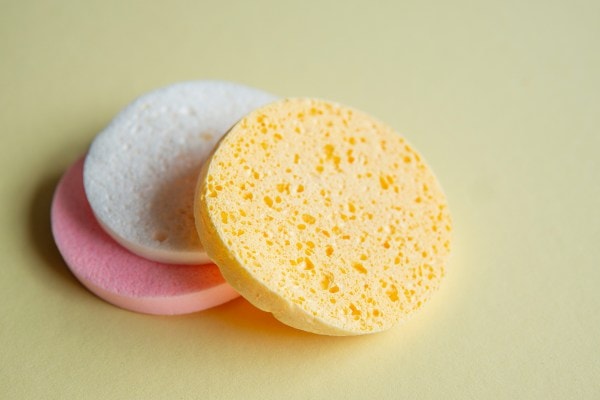
Think of cellulose sponges as the dependable friend who’s always around when you need a hand.
Made from wood pulp and filled with tiny holes, these sponges soak up spills like a champ. You’ll often find them hanging out by the kitchen sink, tackling everyday messes without fuss—whether it’s wiping up coffee spills, cleaning surfaces, or doing a quick dishwashing session after breakfast.
These cellulose sponges are soft, lightweight, and gentle on most surfaces, which makes them perfect for everyday usage—like cleaning dishes, mopping up warm water around the sink, or wiping crumbs off the dining table.
But don’t let their softness fool you—they’re not cut out for everything. If you’re dealing with stubborn grime, baked-on food, or raw meat juices, it’s best to grab a tougher, more specialized cleaning tool to avoid spreading bacteria or damaging the sponge.
Eco-conscious?
You’ll appreciate that cellulose sponges are biodegradable and break down more quickly than synthetic materials. Just know they’ll need a little extra TLC—rinse thoroughly after each use, squeeze out excess moisture, and let them dry completely.
A damp sponge left on the counter can become a magnet for bacteria faster than you’d think.
When used right, cellulose sponges are a reliable go-to for everyday household cleaning jobs. They may not win against stuck-on food or tough grime, but for your daily dish washing and countertop cleanup—they’re hard to beat.
2. Abrasive Scrubber Sponge (Dual-Sided)
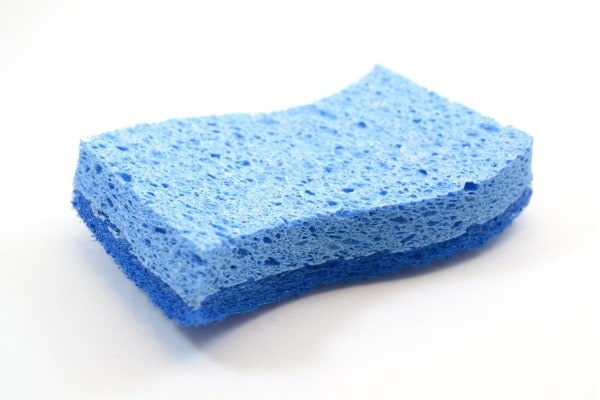
Ever wished your sponge could multitask like you do? Enter the dual-sided abrasive scrubber sponge—a true overachiever in the world of cleaning sponges.
One side’s soft and smooth, perfect for gentle wiping, while the other brings the muscle with an abrasive surface ready to take on grease, grime, and stuck-on food.
These sponges are a kitchen favorite for a reason.
Let’s say you’re cleaning surfaces like your kitchen sink or tackling that spaghetti-stained pot—flip to the rough side to break down the mess. Then, switch to the softer side to wipe everything clean.
It’s this two-in-one magic that makes them ideal for everyday tasks like cleaning dishes, scrubbing stovetops, or giving your bathroom sink a quick refresh.
But here’s the catch: the scrub side isn’t meant for everything.
If you’re dealing with non-stick cookware or delicate glass, steer clear unless the packaging clearly says “non-scratch.” The last thing you want is to ruin your favorite frying pan over a stubborn piece of food.
These come in varying levels of toughness—from light-duty versions great for cleaning jobs around the house to heavy-duty ones that can stand up to baked-on stains in metal pots and pans.
Choose your scrub strength wisely, and always check the label if you’re unsure.
When used properly, a dual-sided sponge is like having two tools in one—saving you time, effort, and a whole lot of scrubbing.
3. Magic Eraser (Melamine Sponge)

It may look like a plain white block, but the Magic Eraser is anything but boring.
This sponge has earned near-legend status in homes with kids, pets, and scuffed-up walls. Made from melamine foam, it works like ultra-fine sandpaper—gently shaving off grime without the need for harsh chemicals.
What makes it magic? Just add warm water.
That’s it. Suddenly, crayon drawings on your living room wall, pencil marks on doors, or soap scum clinging to your bathroom tiles disappear with minimal effort. Parents swear by it, especially when facing a spontaneous toddler art exhibit on freshly painted walls.
These cleaning sponges are a lifesaver for baseboards, grout lines, and even light switches that tend to collect grime over time. And since they’re chemical-free, they’re perfect for quick touch-ups without filling the air with cleaning product fumes.
But don’t get carried away—melamine sponges aren’t meant for everything.
They’re not safe for your skin, shouldn’t be used on high-gloss or polished surfaces, and they do wear down quickly. Each sponge lasts only a few sessions before it starts crumbling—kind of like a pencil eraser losing its edge.
If you’re dealing with stubborn marks in high-traffic areas or need a quick fix for an accidental mess, the Magic Eraser is your go-to.
It’s one of those tools that proves cleaning doesn’t always need fancy products—just the right sponge and a bit of water.
4. Microfiber Sponge
If there were a sponge that acted like a magnet for dust and smudges, the microfiber sponge would be it.
Soft to the touch but tough on dirt, this sponge blends the best of both worlds—absorbent padding wrapped in microfiber cloth that clings to particles like static cling on laundry day.
What makes microfiber different is its ability to clean even without soap.
Dry, it lifts dust from delicate surfaces like TV screens or fabric window coverings. Damp, it glides across stainless steel surfaces, bathroom mirrors, or even car dashboards without leaving a streak behind.
It’s the kind of cleaning tool you’ll reach for when you want results without the fuss.
Whether you’re polishing up delicate glassware or giving your laptop a gentle refresh, microfiber sponges get the job done with care.
Just don’t expose them to hot water or high heat—synthetic materials can melt, and that ruins both the fibers and your finish.
Unlike single-use cleaning sponges, these are washable and reusable. Toss them in the laundry after a few uses, and they’re ready to go again.
So, if you’re after a cleaning tool that handles the small stuff with big impact—this one’s a keeper.
5. Natural Sea Sponge
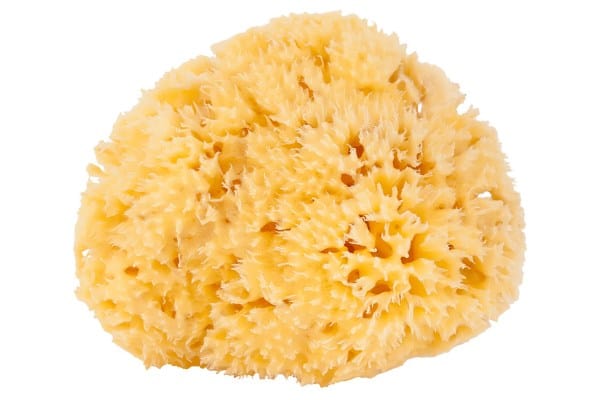
Imagine reaching for a sponge that feels like it came straight from a luxury spa—because it did.
Natural sea sponges, harvested right from the ocean, bring a touch of nature into your cleaning routine. These soft, highly absorbent sponges are known for holding a large amount of water while being gentle on skin and delicate surfaces.
They’re often spotted in bathrooms, not just for cleaning but for bath time, too.
Many people use them as exfoliators in the shower, and they’re also great for wiping down bathroom surfaces like sinks or tubs without scratching. Some even use them for applying wax to cars or furniture, thanks to their ability to spread evenly without leaving streaks.
That said, sea sponges have their limits.
They don’t play well with bleach or strong cleaning chemicals—those can break down their natural fibers quickly. And while they’re incredibly durable with proper care, they are a bit of an investment compared to other sponges.
They’re also harder to find in your average grocery store, so you may need to look online or in specialty shops.
Still, if you want a sponge that’s long-lasting, naturally sourced, and a little bit fancy, the sea sponge earns its spot in your cleaning toolkit. Just rinse well, let it dry fully, and it’ll stick around far longer than you’d expect.
6. Steel Wool Sponge
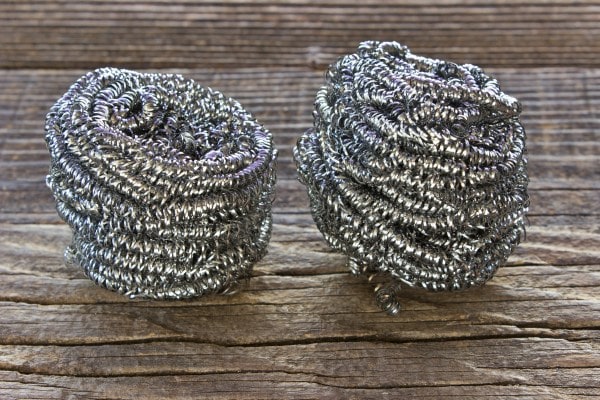
When soft sponges just don’t cut it, steel wool steps in like the tough guy of the cleaning crew.
Made from ultra-fine, flexible sharp-edged steel fibers, this wire sponge isn’t here to mess around. It’s the go-to cleaning tool for those heavy-duty jobs that need serious scrubbing power.
Think baked-on food crusted to oven racks, rust clinging to outdoor furniture, or burnt barbecue residue on grill grates—steel wool tackles them all without flinching.
It’s also a favorite for cleaning cast iron pans, helping to remove stuck-on food without ruining the seasoning. Surprisingly, some grades of steel wool are gentle enough to be used on porcelain and certain types of glass, provided the underlying surface can tolerate abrasive material.
But be warned—this isn’t a sponge you want anywhere near delicate surfaces.
Skip it on non-stick cookware, painted surfaces, or anything prone to scratching, like glossy tiles or Teflon-coated pans. It can do more harm than good in the wrong setting.
Steel wool sponges are powerful, but they do come with one small catch—they rust easily if left wet. Always rinse and dry them thoroughly after use to keep them in top shape.
If you’ve got a tough job that calls for real grit, this is the sponge type you’ll want in your back pocket.
7. Silicone Sponge
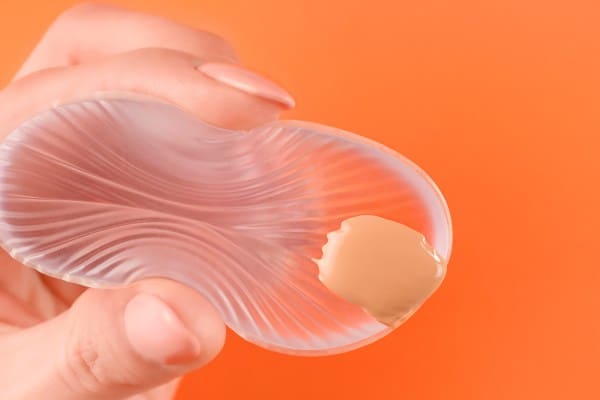
If traditional sponges had a modern cousin, it would be the silicone sponge—sleek, flexible, and designed to stay cleaner for longer.
Unlike those old-school porous options that soak up everything (including germs), silicone sponges are non-porous, quick-drying, and surprisingly low-maintenance. A quick rinse or a ride in the dishwasher, and they’re good as new.
These sponges shine when it comes to light dishwashing and safe scrubbing on nonstick cookware.
Need to gently clean a pan without risking damage? Silicone’s your friend. They’re also great for allergy-prone households, since they don’t trap allergens, dirt, or food bits the way other sponges do. No funky smells. No questionable textures.
But they’re not without limits.
If you’ve got a big juice spill or need to absorb warm water from your kitchen counter, a silicone sponge might not cut it. It just doesn’t hold liquid like a cellulose or combo sponge. That’s why many people pair silicone sponges with more absorbent options for a full cleaning toolkit.
Still, for everyday dishwashing and germ-free peace of mind, silicone sponges make a smart, sanitary upgrade.
Plus, they often come in bright colors and fun shapes (like the famous Scrub Daddy)—so your cleaning tool doesn’t have to be boring.
8. Copper Scrub Sponge
Copper scrub sponges might look delicate, but don’t let their shine fool you—they’re built to battle grime without being overly aggressive. Unlike steel wool, which can be a little too harsh, copper sponges offer just the right amount of abrasion.
They’re strong enough to lift stuck-on messes but soft enough to avoid scratching most metal surfaces.
These sponges are a go-to for cleaning stainless steel cookware, reviving dulled copper pots, or gently scrubbing residue from glass stovetops—so long as the label gives the green light.
Since copper doesn’t rust, it holds up longer than steel scrubbers and keeps its structure even after repeated use.
Where do they fall short?
They’re not suitable for non-stick cookware or delicate surfaces like decorative glass. You’ll want to reach for something gentler in those cases. But for tough jobs where precision matters—like restoring shine to your favorite metal pans without leaving swirl marks—copper scrubbers hit the mark.
9. Loofah Sponge

At first glance, a loofah sponge might remind you of a spa day—but this plant-based scrubber isn’t just for showers.
Made from the dried fibers of the luffa plant (yes, it’s a gourd!), loofahs bring a natural twist to your cleaning routine. They’re a favorite among eco-conscious households looking to reduce waste without sacrificing scrubbing power.
What sets loofahs apart is their gentle yet gritty texture. They’re firm enough to scrub off dirt and food bits, but soft enough not to damage delicate surfaces.
Many people use natural loofahs in the kitchen to wash dishes or clean produce without leaving scratches. Synthetic versions, often made of plastic mesh, are popular in bathrooms for their softer, foamy lather—think bath poufs.
Loofahs are fully compostable and biodegradable when natural, which makes them a smart swap if you’re ditching synthetic sponges. Just keep in mind, they don’t last forever.
For hygiene’s sake—especially if used in the shower—swap them out every 3 to 4 weeks.
Whether you’re gently cleaning non-stick pans, giving vegetables a quick scrub, or adding a little eco-friendliness to your sponge stash, the loofah is a natural choice that does more than just look good.
How to Care for Your Cleaning Sponges?
A sponge can only clean as well as it’s cared for. Neglect it, and you’re not just spreading dirt—you’re spreading bacteria. Taking a few simple steps can keep your sponges fresh, functional, and safe to use around your home.
Here’s how to make the most of your sponge’s life :
- Rinse thoroughly after each use. Don’t just give it a quick shake—flush out food bits and soap residue, then squeeze out as much water as you can.
- Store it dry. Never leave your sponge soaking in the sink. Use a holder or place it somewhere with good airflow to help it dry faster.
- Disinfect weekly to kill bacteria:
- Soak in a vinegar or diluted bleach solution for 5 minutes.
- Microwave a damp cellulose sponge for 1 minute (never microwave dry or metal-based sponges).
- Replace often. Even with regular care, sponges don’t last forever. Replace:
- Every 1–2 weeks
- Immediately if it smells sour, starts to fall apart, or looks grimy
- Avoid cross-contamination. Keep separate sponges for:
- Dishes and countertops
- Bathrooms and toilets
- Outdoor furniture or tough jobs
A little sponge care goes a long way—keeping your home cleaner and your surfaces safer. And if you’re not sure whether your sponge is still up for the job? It’s probably time to grab a new one.
Match the Sponge to the Task for Better Cleaning Results
Choosing the right sponge isn’t just a matter of personal taste—it’s the difference between sparkling results and scratched-up regrets. Whether you’re dealing with stainless steel surfaces, dirty pots, or delicate glass, matching the sponge to the surface means faster cleaning, less damage, and way fewer germs lurking in corners.
Here’s a pro tip: Don’t rely on one sponge to do it all. Keep a few types on hand—maybe a soft cellulose sponge for dishes, a microfiber for electronics, and a scrubber for those “how did this get so gross?” moments in the bathroom. It’ll save you time, protect your stuff, and help avoid cross-contamination between rooms.
And hey, sometimes even your best sponge needs backup. When it’s time for a full-home reset or a deep clean that no amount of elbow grease can handle, Atlanta Maids has your back.
Whether it’s a spotless kitchen, a grime-free bathroom, or a refresh from top to bottom, we bring the skills (and tools) to make your home feel brand new.
Call us at (404) 905-5141
Book your service instantly: atlantamaids.com/booking-page
Let us take care of the mess—so your sponges last longer, your surfaces stay damage-free, and you can finally take cleaning off your to-do list.

